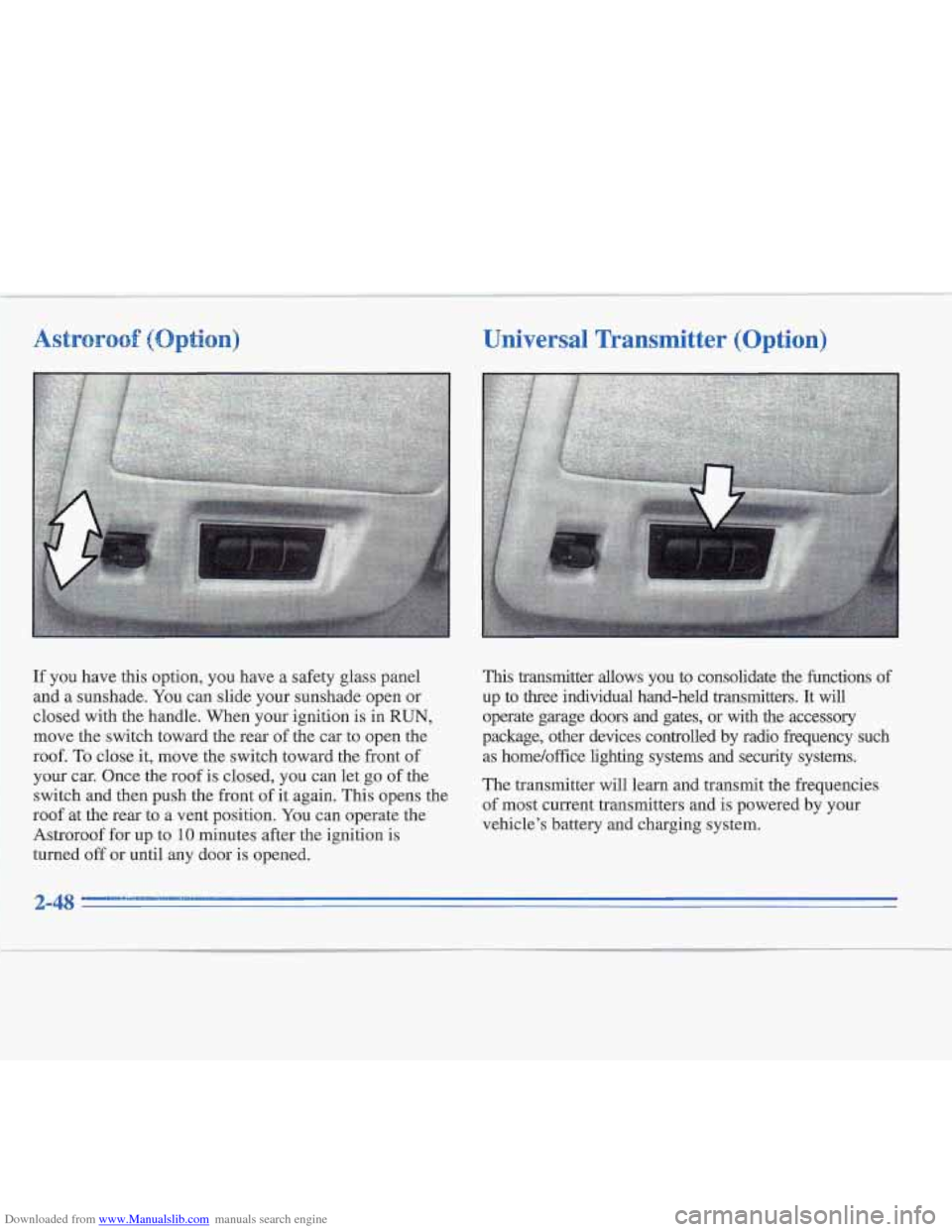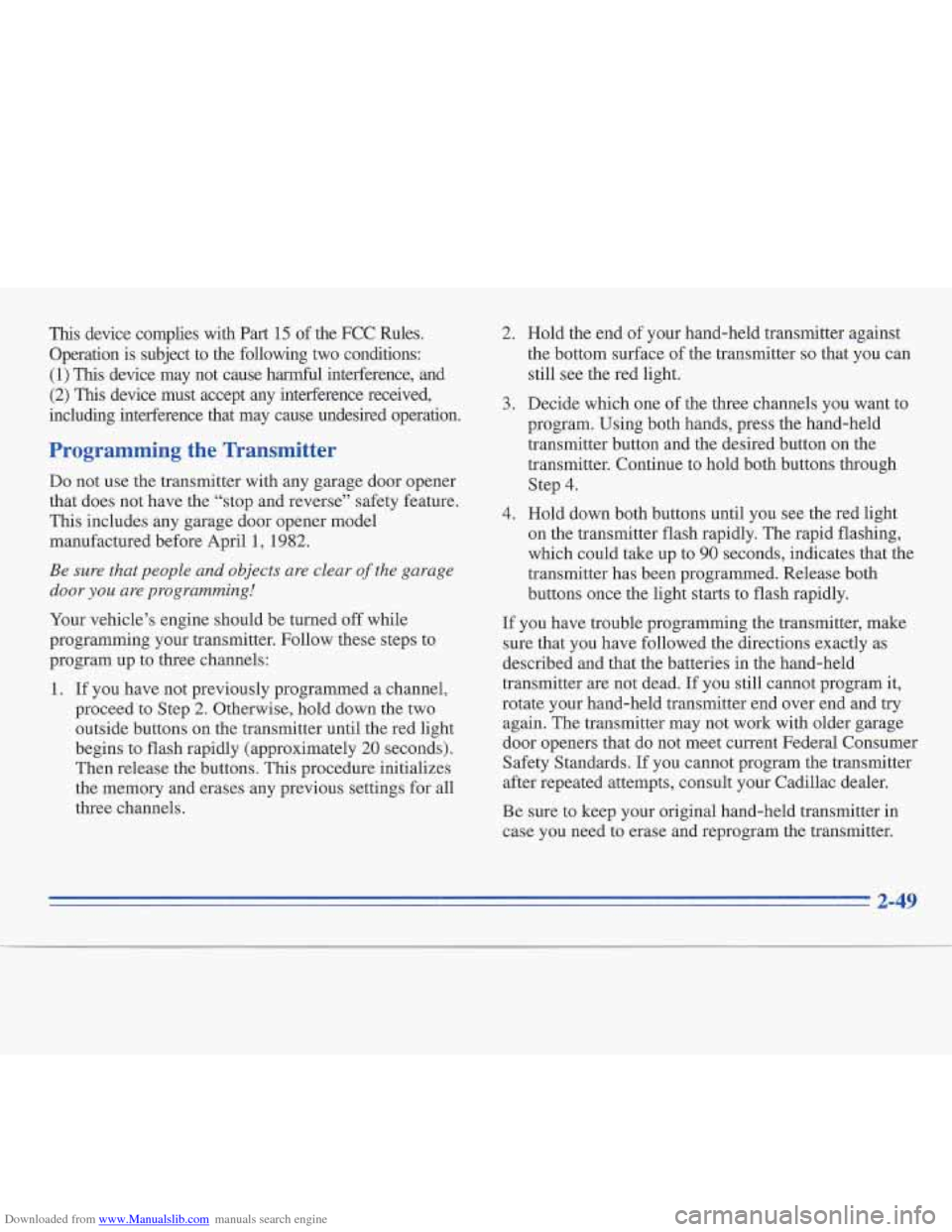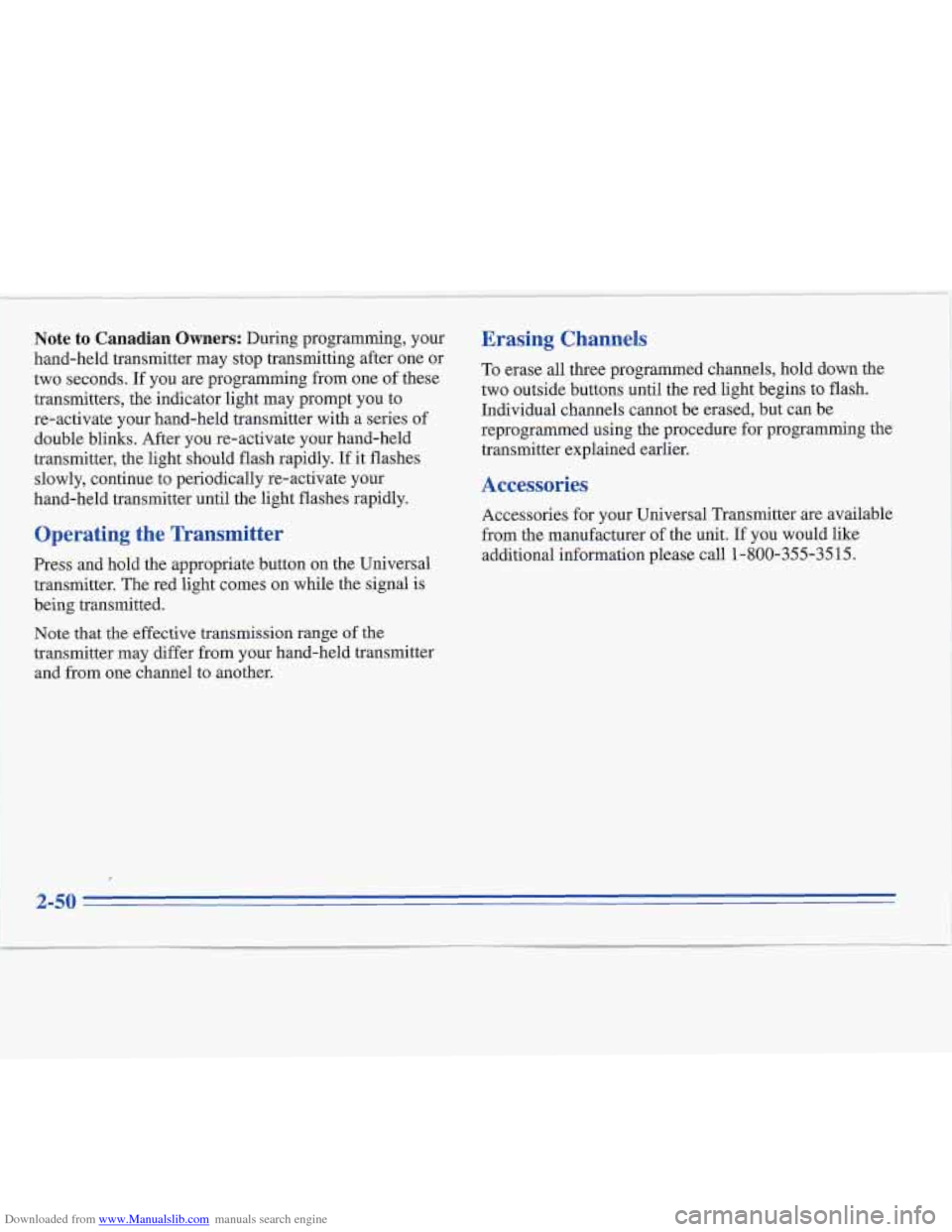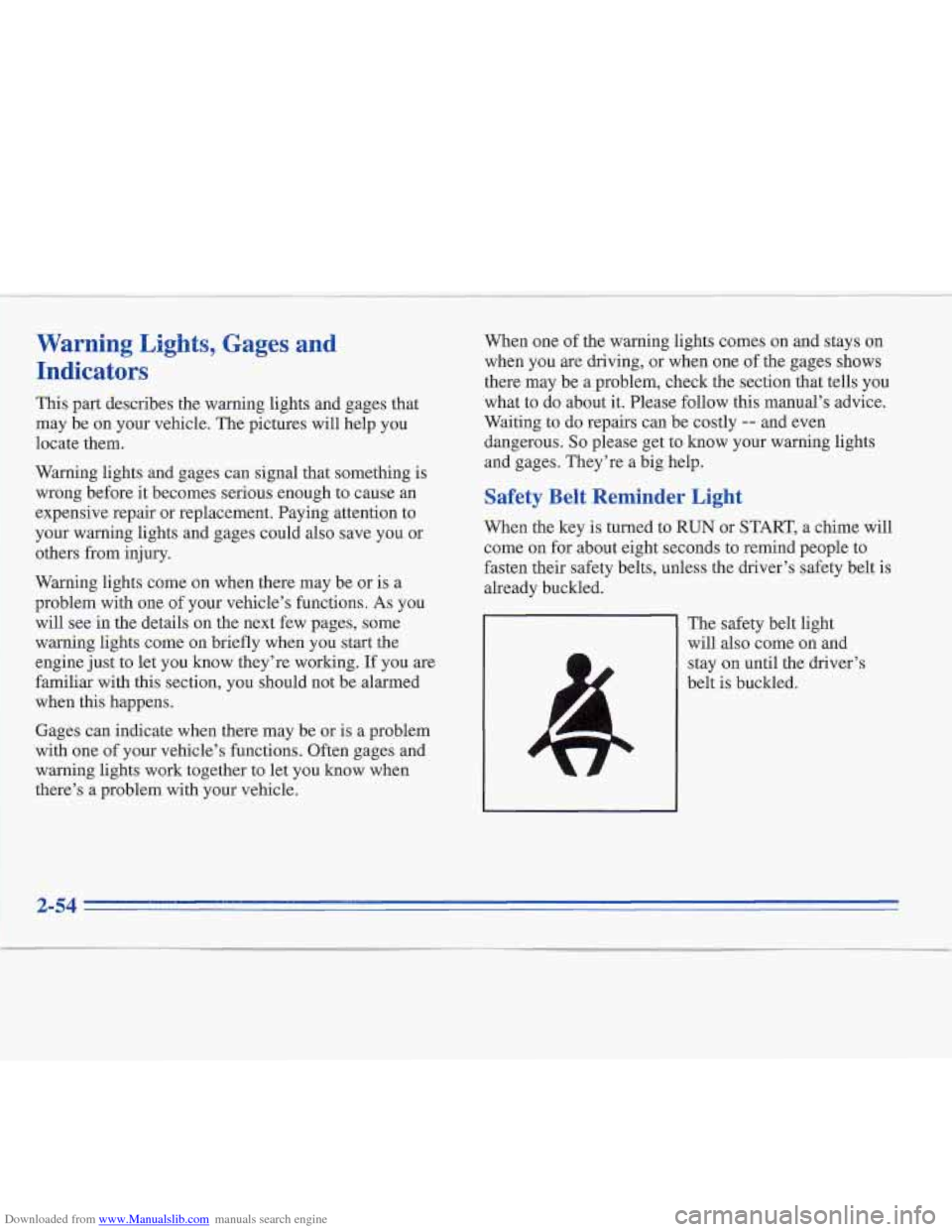Page 98 of 306

Downloaded from www.Manualslib.com manuals search engine When the DRL are on, only your low-beam headlamps
will be on. The taillamps, sidemarker and other lamps
won’t be on. Your instrument panel won’t be lit up eithe\
r.
When it’s dark enough outside,
your low-beam headlamps
will change to full brightness. The other lamps that come
on with your headlamps will
also come on.
When it’s bright enough outside, the regular lamps will
go off, and your low-beam headlamps change to the
reduced brightness of DRL.
To idle your vehicle with the DRL off, set your gear
selector in park before you turn on the ignition. Once
you shift out of park, the DRL cannot be turned
off as
long as the ignition is on.
As with any vehicle, you should turn on the regular
headlamp system when you need
it.
Cornering La.-ps
If the exterior lamps are on, the cornering lamps will
come on when you signal a turn. This will provide more
light for cornering when its dark.
Sei
The Twilight Sentinel control is under the headlamp
knob. It turns your lamps on and
off by sensing how
dark it is outside. To operate it, leave the lamp knob
off
and move the Twilight Sentinel control to any position
but
OFF.
If you move the control all the way to MAX, your lamps
will stay
on for about four minutes after you turn the
ignition to
OFF. If you move the control almost all the
way in the other direction,
so it’s just on, the lamps will ,
go off quickly when you turn the ignition to OFF.
The light sensor is located on
top of the instrument panel.
Do not cover the sensor. If
you do, it will sense that is is
dark outside and your lamps
will come on.
Page 101 of 306
Downloaded from www.Manualslib.com manuals search engine Mirrors
Electrochromic Mirror
Your Cadillac has an automatic inside rearview mirror.
During the day
it works like a regular mirror, but at
night it adjusts for the glare of headlamps behind you.
The
mirror delays before switching from day to night
mode.
This change may take a few seconds. This delay
prevents rapid changing of the mirror as you drive under
lights and through traffic.
On/Off Switch
Press the switch located at the base of the mirror to turn
on the auto-dimming feature. Press it
again to turn off.
Reverse Gear Day Mode
When the shift lever is placed in REVERSE (R), the
mirror changes to the daytime mode for a bright image
in the mirror as you back up.
Front Reading Lamps
There are two reading lamps located on the rearview
mirror.
Press the switch next to the lamp that you want
to turn on
or off.
Page 105 of 306
Downloaded from www.Manualslib.com manuals search engine Ashtrays and Cigarette Lighter
To remove the rront center ashtray for cleaning, lift it
out by pulling on the snuffer. If it won’t come out, reach
under the drawer and push up on the ashtray bowl and
remove it
.
The rear ashtrays are located on the door armrests. To
remove the ashtrays for cleaning, lift the cover and pull
up on the snuffer.
To reinstall, push down firmly.
NOTICE:
Don’t put papers or other flammable things into
your
ashtrays. Hot cigarettes or other smoking
materials could ignite them, causing damage.
Lighters are near the ashtrays. To use a lighter, push it in
all the way. When it’s ready, it will pop back out by itself.
NOTICE:
If you hold a cigarette lighter in with your hand
while it
is heating, it won’t be able to back away
from the heating element when
it’s ready. That
can make
it overheat, damaging the lighter and
the heating element.
2-46
Page 107 of 306

Downloaded from www.Manualslib.com manuals search engine Universal Transmitter (Option)
I€ you have this option, you have a safety glass panel
and a sunshade.
You can slide your sunshade open or
closed with the handle. When your ignition is in
RUN,
move the switch toward the rear of the car to open the
roof. To close it, move the switch toward the fiont
of
your car. Once the roof is clo-sed, you can let go of the
switch and then
push the front of it again. This opens the
roof at the rear to a vent position. You can operate the
Astroroof
for up to 10 minutes after the ignition is
turned off or until any door is opened.
This transmitter allows you to consolidate the functions of
up to three individual hand-held transmitters. It will
operate garage doors and gates, or with the accessory
package, other devices controlled by radio frequency such as home/office lighting systems
and security systems.
The transmitter will leam and .transmit the frequencies
of most current transmitters and
is powered by your
vehicle’s battery and charging system.
2-48
Page 108 of 306

Downloaded from www.Manualslib.com manuals search engine This device complies with Part 15 of the FCC Rules.
Operation is subject to the following two conditions:
(1) Th~s device may not cause harmful interference, and
(2) This device must accept any interference received,
including interference that may cause undesired operation.
Programming the Transmitter
Do not use the transmitter with any garage door opener
that does not have the “stop and reverse’’ safety feature.
This includes any garage door opener model
manufactured before April
1, 1982.
Be sure that people and objects are clear of the garage
door
you are programming!
Your vehicle’s engine should be turned off while
programming your transmitter. Follow these steps to
program up to three channels:
1. If you have not previously programmed a channel,
proceed to Step
2. Otherwise, hold down the two
outside buttons on the transmitter until the red light
begins to flash rapidly (approximately
20 seconds).
Then release the buttons. This procedure initializes
the memory and erases any previous settings for all
three channels.
2. Hold the end of your hand-held transmitter against
the bottom surface
of the transmitter so that you can
still see the red light.
3. Decide which one of the three channels you want to
program. Using both hands, press the hand-held
transmitter button and the desired button on the
transmitter. Continue to hold both buttons through
Step
4.
4. Hold down both buttons until you see the red light
on the transmitter flash rapidly. The rapid flashing,
which could take up to
90 seconds, indicates that the
transmitter has been programmed. Release both
buttons once the light starts to flash rapidly.
If you have trouble programming the transmitter, make
sure that you have followed the directions exactly as
described and that the batteries in the hand-held
transmitter
are not dead. If you still cannot program it,
rotate your hand-held transmitter end over end and try
again. The transmitter may not work with older garage
door openers that do not meet current Federal Consumer
Safety Standards. If you cannot program the transmitter
after repeated attempts, consult your Cadillac dealer.
Be sure to keep your original hand-held transmitter in
case you need to erase and reprogram the transmitter.
Page 109 of 306

Downloaded from www.Manualslib.com manuals search engine Note to Canadian Owners: During programming, your
hand-held transmitter may stop transmitting after one or
two seconds.
If you are programming from one of these
transmitters, the indicator light may prompt you to
re-activate your hand-held transmitter with a series of double blinks. After you re-activate your hand-held
transmitter, the light should flash rapidly. If it flashes
slowly, continue to periodically re-activate your
hand-held transmitter until the light flashes rapidly.
Operating the Transmitter
Press and hold the appropriate button on the Universal
transmitter. The red light comes on while the signal
is
being transmitted.
Note that the effective transmission range of the
transmitter may differ from your hand-held transmitter
and
from one channel to another.
Erasing Channels
To erase all three programmed channels, hold down the
two outside buttons until the red light begins to flash.
Individual channels cannot be erased, but can be
reprogrammed using the procedure for programming the
transmitter explained earlier.
Accessories
Accessories for your Universal Transmitter are available
from the manufacturer
of the unit. If you would like
additional information please call 1-800-355-3515.
2-50
Page 110 of 306
Downloaded from www.Manualslib.com manuals search engine Instrument Panel
1. Side Vents
2. Main Lamp Control
3. Instrument Cluster
4. Center Vents
5. Comfort Controls
6. Glove Box
7. Ashtray and Cigarette Lighter
8. Audio System
9. Transmission Shift Lever
10. Horn
11. Multifanction Lever
2-51
Page 113 of 306

Downloaded from www.Manualslib.com manuals search engine Warning Lights. Gages and
Indicators
This part describes the warning lights and gages that
may be
on your vehicle. The pictures will help you
locate them.
Warning lights and gages can signal that something is
wrong before it becomes serious enough to cause an
expensive repair or replacement. Paying attention to
your warning lights and gages could also save you or
others from injury.
Warning lights come on when there may be or is a
problem with one
of your vehicle’s functions. As you
will see in the details on the next few pages, some
warning lights come on briefly when you start the
engine just to let you know they’re working. If you are
familiar with this section, you should not be alarmed
when this happens.
Gages can indicate when there may be or
is a problem
with one of your vehicle’s functions. Often gages and
warning lights work together to let you know when
there’s a problem with your vehicle. When
one
of the warning lights comes on and stays on
when you are driving, or when one of the gages shows
there may be a problem, check the section that tells you
what
to do about it. Please follow this manual’s advice.
Waiting to do repairs can be costly
-- and even
dangerous.
So please get to know your warning lights
and gages. They’re a big help.
Safety Belt Reminder Light
When the key is turned to RUN or START, a chime will
come on for about eight seconds to remind people to
fasten their safety belts, unless the driver’s safety belt is
already buckled.
The safety belt light
will also come
on and
stay on until the driver’s
belt is buckled.
2-54